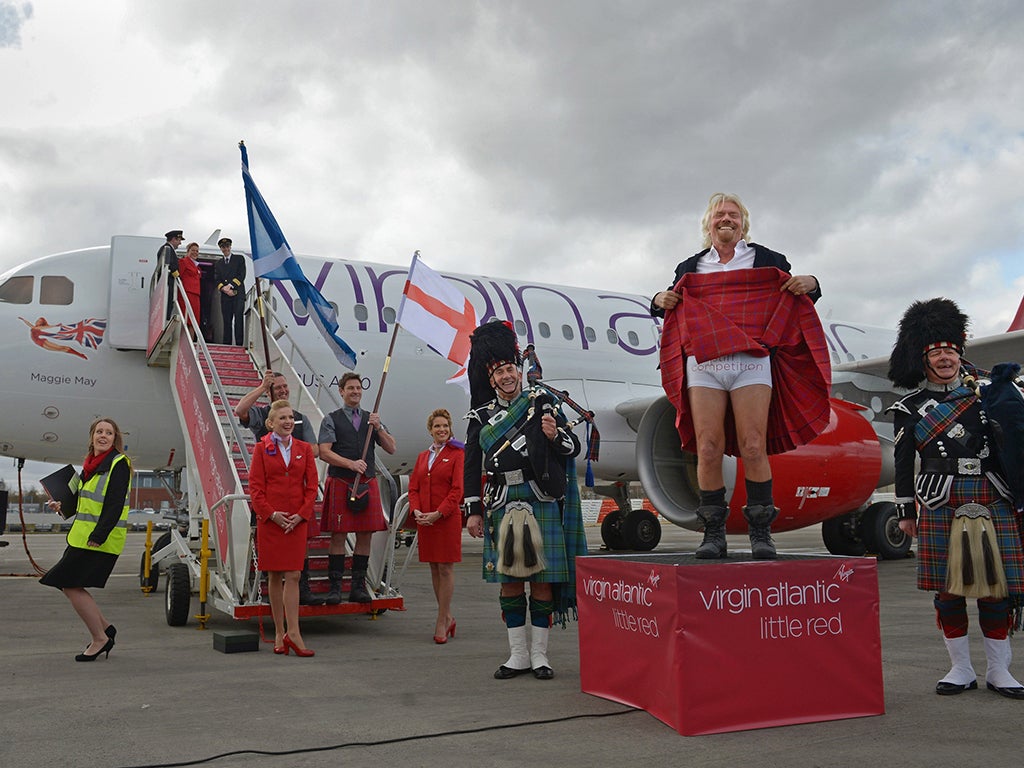Richard Branson's Little Red airline to fold
Virgin's domestic flight network has faced problems from the outset

Sir Richard Branson has blamed aviation regulators for the failure of Virgin’s domestic flight network. “Little Red”, which began in March 2013, connects Heathrow with Manchester, Edinburgh and Aberdeen. But after losing Virgin Atlantic millions of pounds, the Manchester route will close in March 2015. The Scottish links will end six months later.
At the launch, Sir Richard promised Little Red would “deliver Virgin Atlantic’s rock and roll spirit as well as real value for money”.
But as The Independent revealed a year ago, his airline has struggled to fill half the seats on its Airbus A320 jets – even though the Virgin plane is often cheaper than a Virgin train for a last-minute journey.
The Scottish routes were awarded to Virgin as “remedy slots” following British Airways’ takeover of BMI. They were designed to ensure competition to and from the UK’s largest airport. The airline also decided to start Manchester flights using some of its existing slots.
While the aircraft are in Virgin Atlantic colours, they belong to Aer Lingus. The Irish airline “wet-leases” the jets and crew to Virgin, and gets paid regardless of how well or badly the route is performing.
Little Red has faced problems from the outset. Virgin Atlantic’s long-haul departures are from Heathrow Terminal 3, which has no domestic gates. So flights were obliged to use Terminal 1, and have now switched to Terminal 2.
Announcing the closure, Sir Richard Branson said: “When the competition authorities allowed British Airways to take over British Midland [BMI] and all of its slots, we feared there was little we could do to challenge BA’s huge domestic and European network built through decades of dominance. To remedy this, we were offered a meagre package of slots on a short-term basis and decided to lease a couple of planes and give it our best shot. The odds were stacked against us and sadly we just couldn’t attract enough corporate business on these routes.”
The airline says that bookings grew steadily in the first part of 2014, but it appears it was mostly point-to-point passengers taking advantage of cheap flights to and from Heathrow rather than connecting to long-haul routes.
The main beneficiary of Little Red’s demise is British Airways. It will be able to exercise more pricing power on domestic routes to London’s leading airport. In addition, the fact that the only links from three key UK cities to Heathrow will serve BA’s own Terminal 5 means it will pick up some long-haul traffic that would otherwise have gone to Virgin or other airlines. Business travellers who previously used Little Red to the central area of Heathrow will now arrive some distance away, and could be unwilling to make convoluted bus transfers to other terminals.
BA’s holding company, IAG, issued a statement that referred to its previous claims that Virgin is now dominated by Delta - the Atlanta-based carrier which has at 49 per cent share of the airline: “Little Red’s planes are flying about one third full so it is no surprise that the airline’s masters in Atlanta have decided to axe it”.
Join our commenting forum
Join thought-provoking conversations, follow other Independent readers and see their replies
Comments
Bookmark popover
Removed from bookmarks